

Free full-text scholarly articles. Data Analysis, Statistics and Probability authors/titles recent submissions. The Physical Origin of Universal Computing. Imagine you’re shopping for a new car, and the salesperson says, “Did you know, this car doesn’t just drive on the road.”
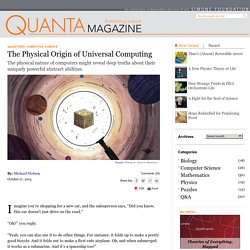
“Oh?” You reply. “Yeah, you can also use it to do other things. Photography Tips & Tutorials.
Resources. Phys lectures acam. Free Physics Video and Audio Courses. These are the free physics video and audio courses.
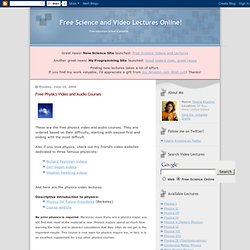
Khan Academy. Science, Math & Tech. Newton and Copernicus.com. Software. Field related info and news. Physics.org. Living Reviews in Relativity. Photonics.com: Optics, Lasers, Imaging & Fiber Information Resource. An Open Access Resource of In-Depth Information, Free Articles, Nonlinear and Fiber Optics. News. Physics World reveals its top 10 breakthroughs for 2011. The two physics stories that dominated the news in 2011 were questions rather than solid scientific results, namely "Do neutrinos travel faster than light?
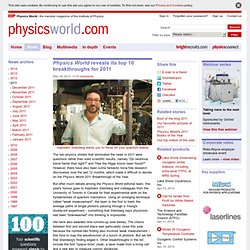
"
Mechanical Principles (1930) by Ralph Steiner [4min selection] BallDroppings. Relativity and "standard model" theories. The Official String Theory Web Site. Imagining the Tenth Dimension - A Book by Rob Bryanton. Dimensions Home. A film for a wide audience!
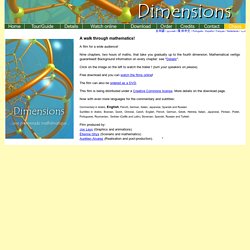
Nine chapters, two hours of maths, that take you gradually up to the fourth dimension. Mathematical vertigo guaranteed! Background information on every chapter: see "Details". Click on the image on the left to watch the trailer ! (turn your speakers on please). HPS 0410 Einstein for Everyone. Title page, Preface and Table of Contents for Einstein for Everyone Introduction: the Questions Special Relativity Special Relativity: the Principles Special Relativity: Clocks and Rods Special Relativity: Adding Velocities.

Special Relativity. Special Relativity These pages are ok as far as they go, but they are missing the planned highlight, to show you what things actually look like when you travel at near the speed of light.
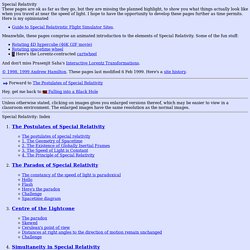
I hope to have the opportunity to develop these pages further as time permits. Here is my opinionated Guide to Special Relativistic Flight Simulator Sites. Meanwhile, these pages comprise an animated introduction to the elements of Special Relativity. General relativity. General relativity, or the general theory of relativity, is the geometric theory of gravitation published by Albert Einstein in 1916[1] and the current description of gravitation in modern physics.
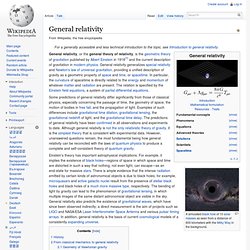
General relativity generalizes special relativity and Newton's law of universal gravitation, providing a unified description of gravity as a geometric property of space and time, or spacetime. In particular, the curvature of spacetime is directly related to the energy and momentum of whatever matter and radiation are present. Alan Kostelecky: Background information on Lorentz/CPT violation. [hep-ph/0308281] Lorentz and CPT Tests in Matter and Antimatter.
Quantum Diaries (Thoughts on work and life from particle physicists from around the world.) Energyparticlewave Physics. Quantum physics. Quantum Physics Online. Nano, Quantum & Statistical Mechanics & Thermodynamics Educational Sites. Thermophysics. The Second Law and Energy (second law event) 110+ Variations of the Second Law of Thermodynamics. Questions about these second law variations?

Know of other second law definitions? Copyright © Institute of Human Thermodynamics and IoHT Publishing Ltd. All Rights Reserved. Feynman 'Fun to Imagine' 1: Jiggling Atoms.
Science, Optics and You. Online Activities for Students The following activities are provided to help you investigate light, optics, and color.
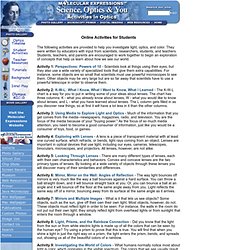
They were written by educators with input from scientists, researchers, students, and teachers. Students, teachers, and parents are encouraged to work together to begin an exploration of concepts that help us learn about how we see our world. Electricity and Magnetism. Articles on "Electricity" Why three prongs?
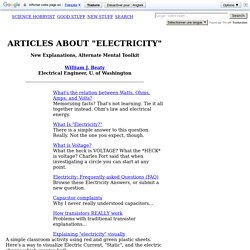
Why do wall outlets have three holes? Maxwell's equations: meaning, derivation and applicability - Classical Physics. Quote So if Coulombs law works best for you, then use coulomb's law - there's no need to re-invent the wheel. Electricity. HyperPhysics. Usenet Physics FAQ. Version Date: March 2013 This list of answers to frequently asked questions in physics was created by Scott Chase in 1992. Its purpose was to provide good answers to questions that had been discussed often in the sci.physics and related Internet news groups. The articles in this FAQ are based on those discussions and on information from good reference sources. They were later maintained and enlarged by Michael Weiss and Philip Gibbs.
Others who have written for the FAQ are credited at the top of the items they submitted, while many more who have made smaller contributions have been thanked privately. UPSCALE Home Page.
Cocktail Party Physics: Physics With a Twist. Physics_For_Entertaiment : Perelman. Top 10 quirky science tricks for parties. The Physics Classroom. Space. View the Universe in different wavelengths. 0.10-bortle.jpg from stellarium.org. 10 Strange Things About The Universe. Space The universe can be a very strange place. While groundbreaking ideas such as quantum theory, relativity and even the Earth going around the Sun might be commonly accepted now, science still continues to show that the universe contains things you might find it difficult to believe, and even more difficult to get your head around. Theoretically, the lowest temperature that can be achieved is absolute zero, exactly ?
273.15°C, where the motion of all particles stops completely. However, you can never actually cool something to this temperature because, in quantum mechanics, every particle has a minimum energy, called “zero-point energy,” which you cannot get below. One of the properties of a negative-energy vacuum is that light actually travels faster in it than it does in a normal vacuum, something that may one day allow people to travel faster than the speed of light in a kind of negative-energy vacuum bubble.
Watch Free Documentaries Online. Gravitational microlensing. Gravitational microlensing is an astronomical phenomenon due to the gravitational lens effect. It can be used to detect objects ranging from the mass of a planet to the mass of a star, regardless of the light they emit. Typically, astronomers can only detect bright objects that emit lots of light (stars) or large objects that block background light (clouds of gas and dust). Gravitational lens. A light source passes behind a gravitational lens (point mass placed in the center of the image).
The aqua circle is the light source as it would be seen if there was no lens, white spots are the multiple images (or Einstein ring) of the source. Zooniverse. Spacehack.